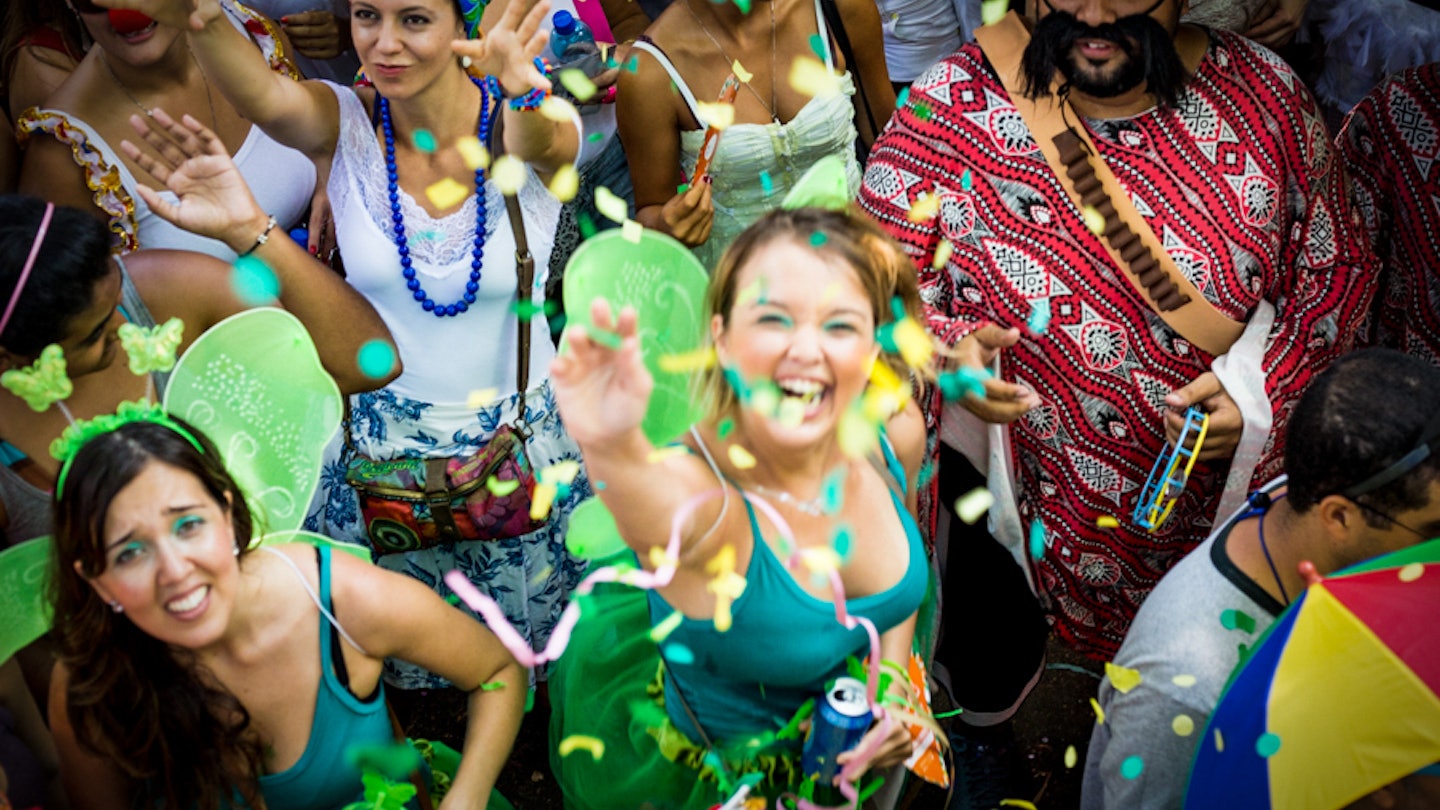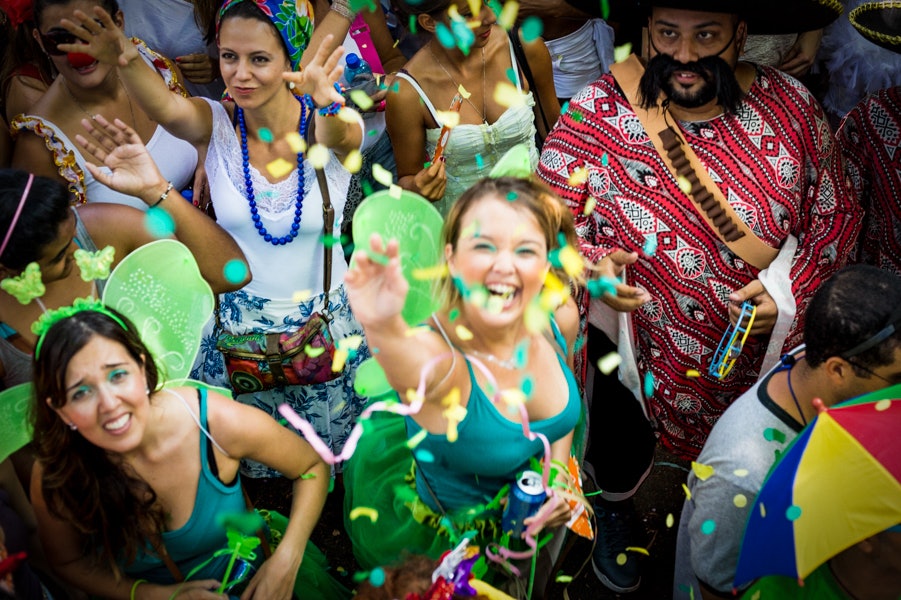
On the ground at Rio’s Carnaval: a local’s guide to the biggest party on earth
Apr 13, 2015 • 5 min read

Every February the infectious sights and sounds of carnaval (carnival) return to Rio de Janeiro. The world’s best known party has taken place in the month before lent since the 1700s and the ‘party of the flesh’ is more alive today than ever, with two million people enjoying Rio’s street parties, known as blocos, each day.
The samba parade is carnival’s main event and the most important time of year for the city's samba schools – this is their chance to show the world the true meaning of spectacular as they perform in the Sambódromo. Elsewhere, the crowds hit the streets as Rio transforms from laid-back beach city to one enormous, 24hr, outdoor nightclub.
Whether it’s the grand samba parade or simply joining in the blocos, nothing on earth can offer an experience quite like the undisputed world-champion of parties, Rio’s carnaval.

Bloco party
The celebrations for carnival start with over 500 official blocos, street parties that begin a month before the week-long samba parades and continue for two weeks after. Truckloads of musicians lead the singing and dancing audience along a designated route where the only rules are there are no rules: men dress as women; women dress in as little as possible; the cerveza and caipirinhas are free flowing; and the famous rat-a-tat of Brazilian percussion is unceasing.
The most traditional blocos take place on the weekends around the samba parade: Cordão do Bola Preta is the oldest and biggest, a polka-dot themed party that fills downtown Rio; Monobloco is one of Brazil’s most famous musical collectives featuring a hundred-strong orchestra of brass and beats; and Banda de Ipanema is one of the most traditional, bringing the classic party to the beach.
Popular modern blocos include Sargento Pimenta (Sergeant Pepper), Brazil’s tribute to The Beatles; boisterous brass band Orquestra Voadora (Flying Orchestra); and Quizomba who blend samba sounds with covers from rock and roll greats like Rage Against The Machine, Nirvana and Sex Pistols.

From 9.30am onwards, the energetic rhythms reverberate through the elated crowds – those with enough stamina will party for the entire day, going from one bloco to the next with their newly found carnival amigos until the early hours of the next morning. The dress code is ‘fun’ and the wackier the costume the better – just watch out for the ‘Bate Bolas’, a group of young men dressed as colorful jesters wielding beach-ball whips. Those not in themed costumes jazz up their outfits with flower tiaras and necklaces, face paint, beer-can-holder hats and glitter galore. To fuel the party atmosphere, men carry trays of tequila shots through the revelers, and street vendors offer coolers of frozen caipirinha popsicles. The alcohol loosens any lingering inhibitions and it’s normal for passionate cariocas to exuberantly kiss a stranger, and then move on to another. Those who refuse a kiss from a local are likely to hear a friendly 'But it’s carnival!'
Staying safe
Although most blocos are heavily policed, it is impossible for their eyes to be on everything at all times. In the larger blocos it’s not unheard of for fights to break out, so stay alert and have a meeting place for a quick escape if necessary. Keep belongings secure and hidden from pickpockets. Wear closed shoes to keep feet protected from broken glass, and puddles of who-knows-what.
The Samba Parade
The Samba Parade, featuring impressive floats, glimmering costumes and some of the most beautiful people in the world, is carnival’s most fantastic event, enjoyed by 80,000 people in the city’s Sambódromo.
Many of the people who work behind the scenes of the parade are from the poorer communities of Rio and can’t afford a ticket to the main event. Instead, they catch performances at the free-entry rehearsals in the weeks before carnival. At the final rehearsal, on the last Sunday before carnival, the most hardcore samba fans and members of school communities fill the seats of the Sambódromo. Although the paraders are not wearing their extravagant costumes and the floats are not out to wow, this is where the most ardent passion for samba lies – the atmosphere is electric as even the oldest men and women in the crowd sing their hearts out and dance their feet off to their school’s anthem.
The main parade highlights twelve samba schools from different communities in the city, each with over 1000 participants, competing through the night from 8pm until 7am. The schools make their procession one after another, with an hour each to present their songs, dances, floats, costumes and themes for the judges who then decide on the year’s winner. The second tier parade is held the day after, and the week finishes with the champions’ parade, showcasing the best six schools.

Tickets sell fast with entertainment worthy of a royal court – great firework displays, exotic costumes, jesters, clowns and an army of drummers and percussionists. The seating is arranged by price, the cheapest at the top of the stadium starting at $60, the most expensive in the air-conditioned VIP boxes starting at $3000. If watching isn’t enough, you can get involved in one of the samba school’s by booking through Rio Tur (rio-carnival.net).
Outside the floodlit floors of the Sambódromo, the lower league parades are held in the streets of historic Lapa neighborhood. These more casual processions are free to watch and give spectators a glimpse of what carnival was like before the TV cameras and commercial sponsors arrived. While the costumes are less flamboyant and the floats more homespun, the spirit is the same joyous celebration of the Marvelous City.













